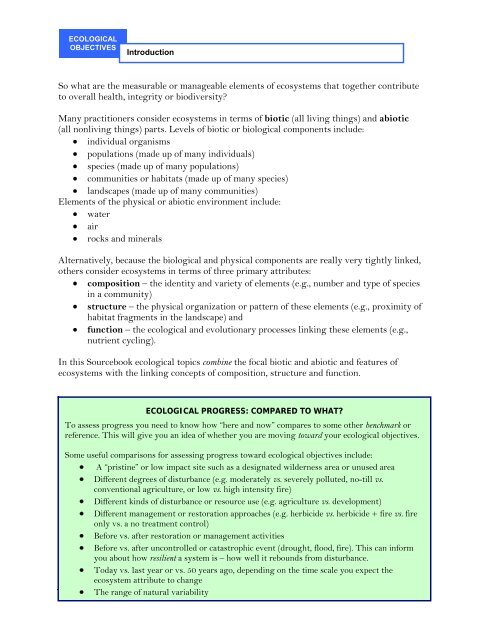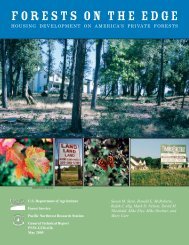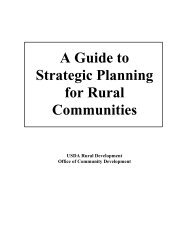Evaluation Sourcebook (.pdf) - School of Natural Resources and ...
Evaluation Sourcebook (.pdf) - School of Natural Resources and ...
Evaluation Sourcebook (.pdf) - School of Natural Resources and ...
- No tags were found...
You also want an ePaper? Increase the reach of your titles
YUMPU automatically turns print PDFs into web optimized ePapers that Google loves.
ECOLOGICALOBJECTIVESIntroductionSo what are the measurable or manageable elements <strong>of</strong> ecosystems that together contributeto overall health, integrity or biodiversity?Many practitioners consider ecosystems in terms <strong>of</strong> biotic (all living things) <strong>and</strong> abiotic(all nonliving things) parts. Levels <strong>of</strong> biotic or biological components include:• individual organisms• populations (made up <strong>of</strong> many individuals)• species (made up <strong>of</strong> many populations)• communities or habitats (made up <strong>of</strong> many species)• l<strong>and</strong>scapes (made up <strong>of</strong> many communities)Elements <strong>of</strong> the physical or abiotic environment include:• water• air• rocks <strong>and</strong> mineralsAlternatively, because the biological <strong>and</strong> physical components are really very tightly linked,others consider ecosystems in terms <strong>of</strong> three primary attributes:• composition – the identity <strong>and</strong> variety <strong>of</strong> elements (e.g., number <strong>and</strong> type <strong>of</strong> speciesin a community)• structure – the physical organization or pattern <strong>of</strong> these elements (e.g., proximity <strong>of</strong>habitat fragments in the l<strong>and</strong>scape) <strong>and</strong>• function – the ecological <strong>and</strong> evolutionary processes linking these elements (e.g.,nutrient cycling).In this <strong>Sourcebook</strong> ecological topics combine the focal biotic <strong>and</strong> abiotic <strong>and</strong> features <strong>of</strong>ecosystems with the linking concepts <strong>of</strong> composition, structure <strong>and</strong> function.ECOLOGICAL PROGRESS: COMPARED TO WHAT?To assess progress you need to know how “here <strong>and</strong> now” compares to some other benchmark orreference. This will give you an idea <strong>of</strong> whether you are moving toward your ecological objectives.Some useful comparisons for assessing progress toward ecological objectives include:• A “pristine” or low impact site such as a designated wilderness area or unused area• Different degrees <strong>of</strong> disturbance (e.g. moderately vs. severely polluted, no-till vs.conventional agriculture, or low vs. high intensity fire)• Different kinds <strong>of</strong> disturbance or resource use (e.g. agriculture vs. development)• Different management or restoration approaches (e.g. herbicide vs. herbicide + fire vs. fireonly vs. a no treatment control)• Before vs. after restoration or management activities• Before vs. after uncontrolled or catastrophic event (drought, flood, fire). This can informyou about how resilient a system is – how well it rebounds from disturbance.• Today vs. last year or vs. 50 years ago, depending on the time scale you expect theecosystem attribute to changeEcosystem • The Management range <strong>of</strong> natural Initiative variability22






